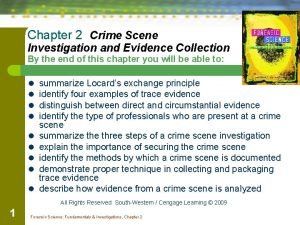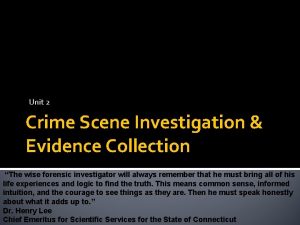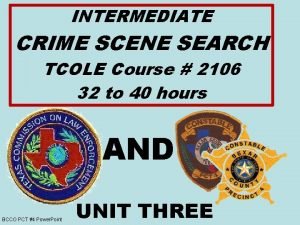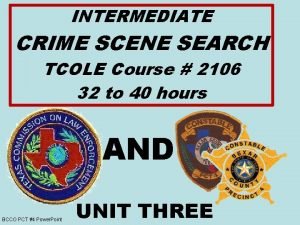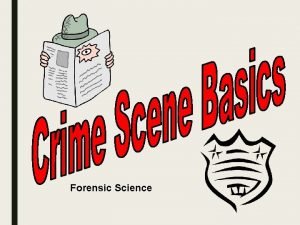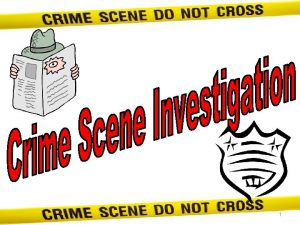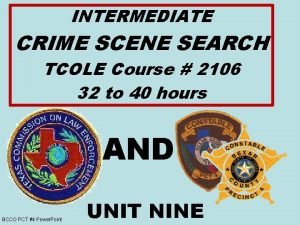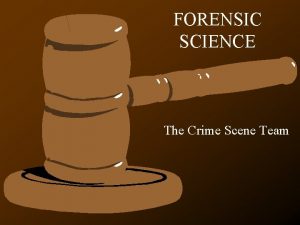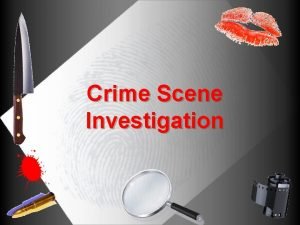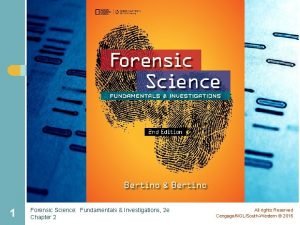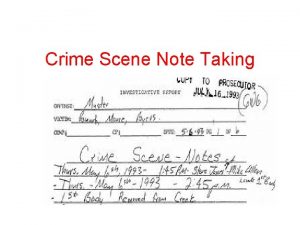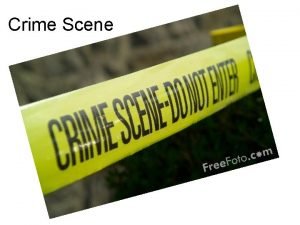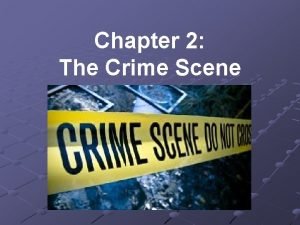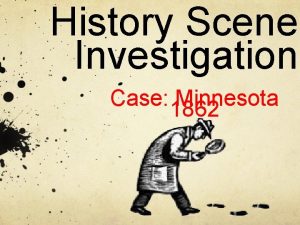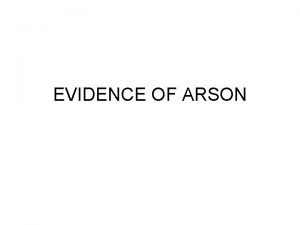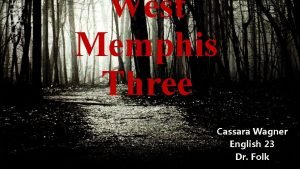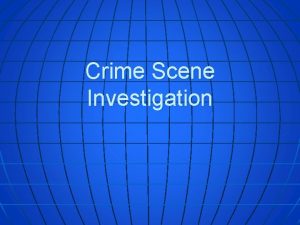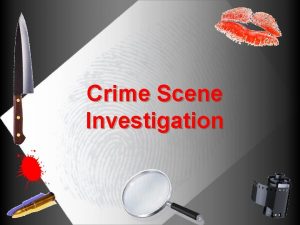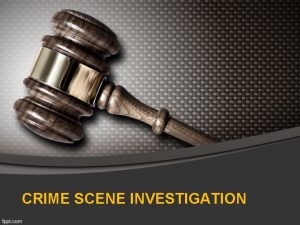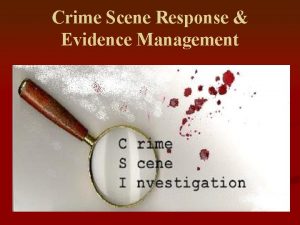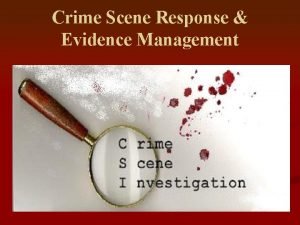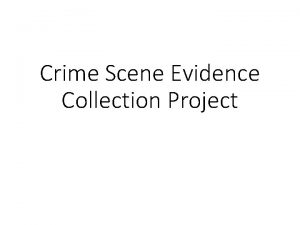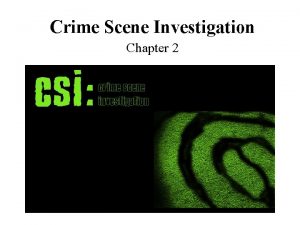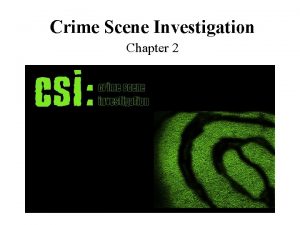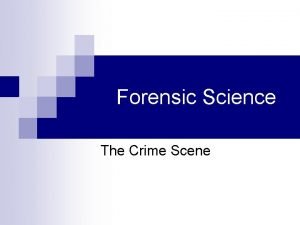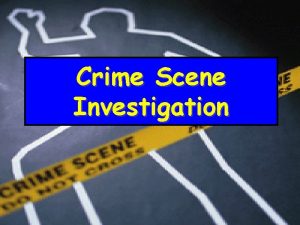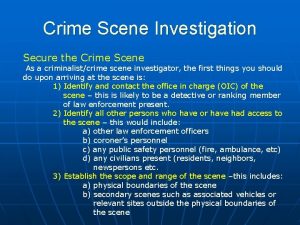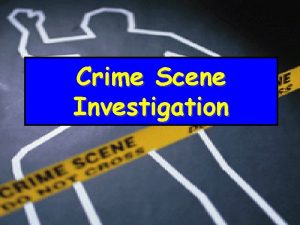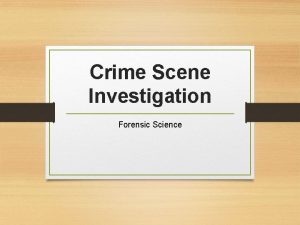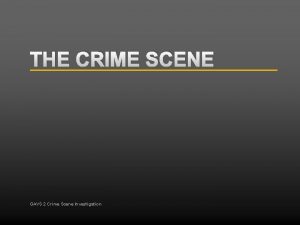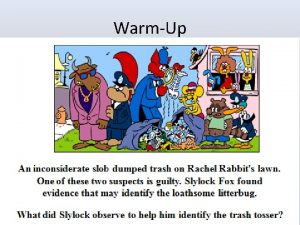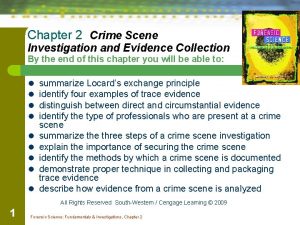Crime Scene Investigation and Evidence Collection Chapter 2






















- Slides: 22

Crime Scene Investigation and Evidence Collection Chapter 2 Goal to recognize, document and collect evidence at a crime scene

Locard’s Principle of Exchange • Part 1: when a person comes into contact with an object or another person, a _____ transfer of physical evidence can occur

Locard’s Principle • Part 2: states that the intensity, _______ and nature of the materials in contact determine the extent of the transfer. • Example: more transfer would occur after a fistfight, than a person simply brushed past another person.

To a forensic examiner, these transferred materials constitute what is called ______ evidence • • • Pet hair on clothes or rugs ______ on brush Fingerprints on glass Soil tracked inside on shoes Drop of ______ on t shirt A used facial tissue Paint chips Broken glass _____ from clothing

Evidence Direct _______ observations: -eyewitness accounts -dashboard video cameras -confessions Circumstantial: - used to imply but prove a fact - may link a suspect and a crime scene ex. Suspect’s gun found at crime scene Physical: Impressions, Fibers, weapons, _____, shell casings reduces number of suspects to group Biological : may make group of suspects very small or even one individual _______, hair, plant parts, natural fibers

Class evidence: ____ the identity to a group ex. Blood type ABO Individual evidence: single person, DNA, fingerprint, combination of _______ traits

Crime Scene Investigation Team: • Police Officers: usually ____ (possibly a DA for a search warrant) • Crime Scene Investigators: document crime and collect physical evidence= ü Recorder ü _______ ü Photographers ü Evidence collectors • • Medical Examiners: aka: ____ may be necessary to determine cause of death in a homicide case Detectives: look for leads, interview witnesses and talking to the CSI about evidence • Specialists: entomologists, psychologists may be required for evidence examination.

7 S’s of CSI 1. 2. 3. 4. 5. 6. 7. Securing the Scene Separating the Witnesses Scanning the Scene Seeing the Scene Sketching the Scene Searching for Evidence Securing and Collecting the Evidence

Securing the Scene • First responding officer’s job • #1 SAFETY • #2 Preserve evidence – Protect area – Limit ______ – Request team

Separating the Witnesses 3 rd priority; try to prevent collusion (creating a story) – Ask the following questions: • • • When did the crime occur? Who called in the crime? Who is the victim? Can the perpetrator be identified? What did you see happen? Where were you when you observed the crime scene?

Scan the scene to determine what photos are needed – May determine primary (where a murder took place) and secondary crime scene (where the body was found)

Seeing the Scene • • • Photos of overall area Close up photos with and without _______ Triangulation of stationary objects should be included in the photos as reference point View needs to be taken from several different _____ and distances Several close up photos of evidence and ______

Sketching the Scene: Ø ____ rough sketch is made noting position of body if applicable and any other evidence ü All objects should be measured from 2 _____ landmarks ü Label N on the sketch and a scale ü Any objects within the _____ of crime scene: windows, furniture, doors…. ü Outside; position of trees, vehicles, shrubs…. ü Make another ______ sketch for court


Searching for Evidence Depends on number of investigators – Walk the scene marking ____ of evidence, photo, sketch – Single investigator: use grid, linear or spiral – Group: linear, _____ or quadrant pattern – Patterns are systematic to ensure no area is left ______ • • • Additional light for hair / fibers Vacuum cleaner Flashlight and _____ reduce picking up extraneous



Securing & Collecting the Evidence Must be properly packaged, ______ and labeled – Specific procedures must be followed for collection and storage • Liquids and arson remains = _______, unbreakable container • Biological evidence: breathable containers to reduce mold • After evidence is allowed to dry then packaged into a paper ____ • Paper bindle (druggist fold) then placed in paper or plastic container • Outer container then sealed with tape and _____ by the collector on the label

Evidence log and Chain of Custody document attached to the evidence container. Contains: – Case number – Item _______ number – Description of the evidence – Name of the suspect – Name of the _______ – Date and Time of recovery – Signature of person recovering evidence – ____ of any witnesses present during collection

Crime Scene Reconstruction _____ sequence of events – from before the crime was committed through its commission. Exam evidence and compare to witness accounts to determine reliability • Evidence does not lie but it can be _______

Staged Crime Scenes Unique problem: evidence does not match ____ Common situations: • Arson: stage fire to cover rubbery, murder • Suicide/murder: death may alcohol or ____ • Burglary: staged to collect be money

Things to consider when determining staging occurred Initially treat all death investigations as homicide • Do the type(s) of wounds found on the victim match the weapon employed? • Could the wounds be easily self inflicted? • Establish a profile of the victim through interviews with friends and family • Evaluate the behavior ( mood and actions) of the victim before the event • Evaluate the behavior ( mood and actions) of any suspects before the event • Corroborate statements with evidential facts • Reconstruct the event • Conduct all forensic examinations to determine the facts of the case
 The seven s's of crime scene investigation
The seven s's of crime scene investigation Seven s of crime scene
Seven s of crime scene Crime scene investigation 2106 tcole course
Crime scene investigation 2106 tcole course Tcole 2106 course
Tcole 2106 course Semen collection bags
Semen collection bags The term encompasses all objects that can establish
The term encompasses all objects that can establish 2106 crime scene investigation
2106 crime scene investigation Rough sketch vs final sketch crime scene
Rough sketch vs final sketch crime scene Crime scene investigation background
Crime scene investigation background What are the 5 steps in crime scene investigation
What are the 5 steps in crime scene investigation Bindle definition forensics
Bindle definition forensics Tcole 2106
Tcole 2106 Crime scene note taking
Crime scene note taking 7 s's of a crime scene
7 s's of a crime scene Evidence crime scene
Evidence crime scene Chapter 2 the crime scene
Chapter 2 the crime scene Historical scene investigation
Historical scene investigation History scene investigation
History scene investigation Graphsketch
Graphsketch Crime scene factoring and quadratic functions answer key
Crime scene factoring and quadratic functions answer key Arson evidence collection and analysis
Arson evidence collection and analysis Individual evidence can have probative value.
Individual evidence can have probative value. West memphis three crime scene photos
West memphis three crime scene photos
